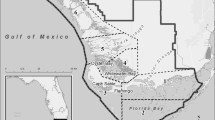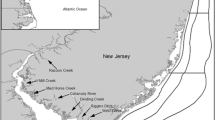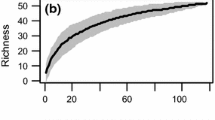Abstract
Small, abundant elasmobranchs use shallow marine areas (<20 m depth) of the US Middle Atlantic coast as nurseries and adult foraging habitat, an area also used by a diverse assemblage of economically important juvenile and adult teleost species. Specimens of three small elasmobranch species (smooth dogfish Mustelus canis, clearnose skate Raja eglanteria, and bullnose ray Myliobatis freminvillii) were collected in August 2007 and 2008 from a study area of ∼150 km2, extending 22 km south from Ocean City, Maryland, USA (38° 19′ N) and offshore from 5- to 20-m depth. Stomach contents indicated that fish were part of the diets of smooth dogfish and clearnose skate at a level comparable with sympatric piscivorous teleosts. However, stable isotope data suggest that piscivory is likely an opportunistic foraging behavior in this habitat. Studied elasmobranchs were secondary-tertiary consumers with diets composed primarily of decapod crustaceans, fish, and mollusks. There was significant overlap in diet composition, spatial distribution, and diel stomach fullness patterns between clearnose skate, southern kingfish Menticirrhus americanus (teleost) and, to a lesser extent, smooth dogfish. Despite this evidence for piscivory, their relatively low densities suggest that predation by these elasmobranchs is unlikely to affect teleost populations in shallow coastal ocean habitats. If shared prey were to become scarce, then competitive interactions are possible.






Similar content being viewed by others
References
Able, K.W., and M.P. Fahay. 1998. The first year of life of estuarine fishes in the Middle Atlantic Bight. New Brunswick: Rutgers University Press.
Akin, S., and K.O. Winemiller. 2006. Seasonal variation in food web composition and structure in a temperate tidal estuary. Estuaries and Coasts 29: 552–567.
Amundsen, P.A., H.M. Gabler, and F.J. Staldvik. 1996. A new approach to graphical analysis of feeding strategy from stomach contents data—modification of the Costello (1990) method. Journal of Fish Biology 48: 607–614.
Bowman, R.E., C.E. Stillwell, W.L. Michaels, and M.D. Grosslein. 2000. Food of Northwest Atlantic fishes and two common species of squid. NOAA Technical Memorandum NMFS-NE-155, pp. 149.
Breder Jr., C.M. 1921. The food of Mustelus canis (Mitchill) in mid-summer. Copeia 101: 85–86.
Brewer, D., N. Rawlinson, S. Eayrs, and C. Burridge. 1998. An assessment of bycatch reduction devices in a tropical Australian prawn trawl fishery. Fisheries Research 36: 195–215.
Buckel, J.A., D.O. Conover, N.D. Steinberg, and K.A. McKown. 1999a. Impact of age-0 bluefish (Pomatomus saltatrix) predation on age-0 fishes in the Hudson River estuary: Evidence for density-dependent loss of juvenile striped bass (Morone saxatilis). Canadian Journal of Fisheries and Aquatic Sciences 56: 275–287.
Buckel, J.A., M.J. Fogarty, and D.O. Conover. 1999b. Foraging habits of bluefish, Pomatomus saltatrix, on the US east coast continental shelf. Fishery Bulletin 97: 758–775.
Bunn, S.E., N.R. Loneragan, and M.A. Kempster. 1995. Effects of acid washing on stable isotope ratios of C and N in penaeid shrimp and seagrass: Implications for food-web studies using multiple stable isotopes. Limnology and Oceanography 40: 622–625.
Castro, J.I. 1993. The shark nursery of Bulls Bay, South Carolina, with a review of the shark nurseries of the southeastern coast of the United States. Environmental Biology of Fishes 38: 37–48.
Chipps, S.R., and J.E. Garvey. 2007. Assessment of diets and feeding patterns. In Analysis and interpretation of freshwater fisheries data, ed. C.S. Guy and M.L. Brown, 473–514. Bethesda: American Fisheries Society.
Clarke, K.R. 1993. Nonparametric multivariate analyses of changes in community structure. Australian Journal of Ecology 18: 117–143.
Ebert, D.A., and J.J. Bizzarro. 2007. Standardized diet compositions and trophic levels of skates (Chondrichthyes: Rajiformes: Rajoidei). Environmental Biology of Fishes 80: 221–237.
Fogarty, M.J., and S.A. Murawski. 1998. Large-scale disturbance and the structure of marine systems: Fishery impacts on Georges Bank. Ecological Applications 8: S6–S22.
Frisk, M.G., T.J. Miller, S.J.D. Martell, and K. Sosebee. 2008. New hypothesis helps explain elasmobranch “OutBurst” on Georges bank in the 1980s. Ecological Applications 18: 234–245.
Gabler, H.M., and P.A. Amundsen. 2009. Feeding strategies, resource utilisation and potential mechanisms for competitive coexistence of Atlantic salmon and alpine bullhead in a sub-Arctic river. Aquatic Ecology. doi:10.1007/s10452-009-9243-x.
Garrison, L.P., and J.S. Link. 2000. Diets of five hake species in the northeast United States continental shelf ecosystem. Marine Ecology Progress Series 204: 243–255.
Gelsleichter, J., J.A. Musick, and S. Nichols. 1999. Food habits of the smooth dogfish, Mustelus canis, dusky shark, Carcharhinus obscurus, Atlantic sharpnose shark, Rhizoprionodon terraenovae, and the sand tiger, Carcharias taurus, from the northwest Atlantic Ocean. Environmental Biology of Fishes 54: 205–217.
Gosner, K.L. 1999. A field guide to the Atlantic seashore: From the Bay of Fundy to Cape Hatteras. Boston: Houghton Mifflin Harcourt.
Hartman, K.J., and S.B. Brandt. 1995. Trophic resource partitioning, diets, and growth of sympatric estuarine predators. Transactions of the American Fisheries Society 124: 520–537.
Herzka, S.Z., S.A. Holt, and G.J. Holt. 2001. Documenting the settlement history of individual fish larvae using stable isotope ratios: Model development and validation. Journal of Experimental Marine Biology and Ecology 265: 49–74.
Hobson, K.A. 1999. Tracing origins and migration of wildlife using stable isotopes: A review. Oecologia 120: 314–326.
Hodges, J.L., and E.L. Lehmann. 1963. Estimates of location based on rank-tests. Annals of Mathematical Statistics 34: 598–611.
Hyslop, E.J. 1980. Stomach contents analysis—a review of methods and their application. Journal of Fish Biology 17: 411–429.
Kempf, A., J. Floeter, and A. Temming. 2008. Predator-prey overlap induced Holling type III functional response in the North Sea fish assemblage. Marine Ecology Progress Series 367: 295–308.
Kwak, T.J., and J.T. Peterson. 2007. Community indices, parameters, and comparisons. In Analysis and interpretation of freshwater fisheries data, ed. C.S. Guy and M.L. Brown, 677–763. Bethesda: American Fisheries Society.
Link, J.S., K. Bolles, and C.G. Milliken. 2002a. The feeding ecology of flatfish in the Northwest Atlantic. Journal of Northwest Atlantic Fishery Science 30: 1–17.
Link, J.S., L.P. Garrison, and F.P. Almeida. 2002b. Ecological interactions between elasmobranchs and groundfish species on the northeastern US continental shelf. I. Evaluating predation. North American Journal of Fisheries Management 22: 550–562.
MacNeill, M.A., G.B. Skomal, and A.T. Fisk. 2005. Stable isotopes from multiple tissues reveal diet switching in sharks. Marine Ecology Progress Series 302: 199–206.
Moran, M.D. 2003. Arguments for rejecting the sequential Bonferroni in ecological studies. Oikos 100: 403–405.
Murdy, E.O., R.S. Birdsong, and J.A. Musick. 1997. Fishes of Chesapeake Bay. Washington: Smithsonian Institution Press.
Musick, J.A., S. Branstetter, and J.A. Colvocoresses. 1993. Trends in shark abundance from 1974 to 1991 for the Chesapeake Bight region of the Mid-Atlantic Coast. In Conservation biology of elasmobranchs, ed. S. Branstetter, 1–18. NOAA Technical Report, NMFS-115, pp. 99.
Myers, R.A., J.K. Baum, T.D. Shepherd, S.P. Powers, and C.H. Peterson. 2007. Cascading effects of the loss of apex predatory sharks from a coastal ocean. Science 315: 1846–1850.
Packer, D.B., S.J. Griesback, P.L. Berrien, C. Zetlin, D.L. Johnson, and W.W. Morse. 1999. Summer flounder, Paralicthys dentatus, life history and habitat characteristics. Essential Fish Habitat Source Document, NOAA Technical Memorandum, NMFS-NE-151, pp. 98.
Packer, D.B., C.A. Zetlin, and J.J. Vitaliano. 2003. Clearnose skate, Raja eglanteria, life history and habitat characteristics. Essential Fish Habitat Source Document, NOAA Technical Memoradum NMFS-NE-174, pp. 50.
Peterson, B.J., and B. Fry. 1987. Stable isotopes in ecosystem studies. Annual Review of Ecology and Systematics 18: 293–320.
Phillips, D.L., and J.W. Gregg. 2001. Uncertainty in source partitioning using stable isotopes. Oecologia 127: 171–179.
Pinnegar, J.K., and N.V.C. Polunin. 1999. Differential fractionation of delta C-13 and delta N-15 among fish tissues: Implications for the study of trophic interactions. Functional Ecology 13: 225–231.
Polis, G.A., and D.R. Strong. 1996. Food web complexity and community dynamics. The American Naturalist 147: 813–846.
Post, D.M. 2002. Using stable isotopes to estimate trophic position: Models, methods, and assumptions. Ecology 83: 703–718.
Post, D.M., C.A. Layman, D.A. Arrington, G. Takimoto, J. Quattrochi, and C.G. Montana. 2007. Getting to the fat of the matter: Models, methods and assumptions for dealing with lipids in stable isotope analyses. Ocecologia 152: 179–189.
Potter, I.C., D.J. Bird, P.N. Claridge, K.R. Clarke, G.A. Hyndes, and L.C. Newton. 2001. Fish fauna of the Severn Estuary. Are there long-term changes in abundance and species composition and are the recruitment patterns of the main marine species correlated? Journal of Experimental Marine Biology and Ecology 258: 15–37.
Prugh, L.R., C.J. Stoner, C.W. Epps, W.T. Bean, W.J. Ripple, A.S. Laliberte, and J.S. Brashares. 2009. The rise of the mesopredator. Bioscience 59: 779–791.
Quinn, G.P., and M.J. Keough. 2003. Experimental design and data analysis for biologists, 2nd ed. Cambridge: Cambridge University Press.
Rountree, R.A., and K.W. Able. 1996. Seasonal abundance, growth, and foraging habits of juvenile smooth dogfish, Mustelus canis, in a New Jersey estuary. Fishery Bulletin 94: 522–534.
Shepherd, T.D., and R.A. Myers. 2005. Direct and indirect fishery effects on small coastal elasmobranchs in the northern Gulf of Mexico. Ecology Letters 8: 1095–1104.
Shurin, J.B., D.S. Gruner, and H. Hillebrand. 2006. All wet or dried up? Real differences between aquatic and terrestrial food webs. Proceedings of the Royal Society B-Biological Sciences 273: 1–9.
Sosebee, K. 2006. Status of fishery resources off the Northeastern United States for 2006: Skates. NOAA Techinical Memborandum, NMFS-NE-115, pp. 106.
Soule, M.E., D.T. Bolger, A.C. Alberts, J. Wright, M. Sorice, and S. Hill. 1988. Reconstructed dynamics of rapid extinctions of chaparral-requiring birds in urban habitat islands. Conservation Biology 2: 75–92.
Swain, D.P., and H.P. Benoit. 2006. Change in habitat associations and geographic distribution of thorny skate (Amblyraja radiata) in the southern Gulf of St Lawrence: Density-dependent habitat selection or response to environmental change? Fisheries Oceanography 15: 166–182.
Vonderweidt, C.M., K. Brewster-Geisz, G. Skomal, D.F. Fisher, and F. Rohde. 2008. Instate fishery management plan for Atlantic coastal sharks. Atlantic State Marine Fisheries Commission, ASMFC-46, pp. 149.
Winemiller, K.O., S. Akin, and S.C. Zeug. 2007. Production sources and food web structure of a temperate tidal estuary: Integration of dietary and stable isotope data. Marine Ecology Progress Series 343: 63–76.
Winkler, G., C. Martineau, J.J. Dodson, W.F. Vincent, and L.E. Johnson. 2007. Trophic dynamics of two sympatric mysid species in an estuarine transition zone. Marine Ecology Progress Series 332: 171–187.
Acknowledgements
The authors thank Rebecca Wingate, Kari Fenske, Lisa Guy, and the crew of the R/V Seawolf for help during field collection and Richard Doucett at Colorado Plateau Stable Isotope Laboratory for aid in stable isotope sample analysis. Joel Fodrie, Edward Houde, and Michael Wilberg and an anonymous reviewer provided valuable editorial suggestions on an earlier draft of this manuscript. The field component of this study was funded by the Bluefish Research Program (NOAA/NMFS/CMER/Rutgers University). Support was also provided by Maryland Sea Grant (NA10OAR4170072).
Author information
Authors and Affiliations
Corresponding author
Rights and permissions
About this article
Cite this article
Woodland, R.J., Secor, D.H. & Wedge, M.E. Trophic Resource Overlap Between Small Elasmobranchs and Sympatric Teleosts in Mid-Atlantic Bight Nearshore Habitats. Estuaries and Coasts 34, 391–404 (2011). https://doi.org/10.1007/s12237-010-9331-0
Received:
Revised:
Accepted:
Published:
Issue Date:
DOI: https://doi.org/10.1007/s12237-010-9331-0




